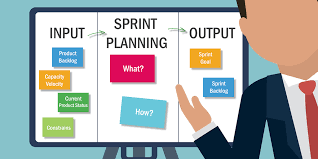Scrum is a lightweight framework for product development, and if you’ve heard of it, you’ve probably heard of the Scrum ceremony. Scrum events, sometimes referred to as scrum ceremonies, are milestone rituals that serve as guidelines for sprints, which are the two- to four-week workflow units that comprise Scrum projects.
Scrum Masters serve as the leaders of Agile Scrum events, just like they do for everything else in this framework. They are there to keep team members organized and sprints on schedule, and they typically take the form of meetings.
What Are the 5 Scrum Ceremonies?
Each Scrum ceremony has a specific purpose and framework. The five Scrum ceremonies are:
Backlog refinement
Sprint planning
Daily Scrum
Sprint review
Sprint retrospective
To facilitate productive meetings, the Scrum Master needs to understand each in detail.
Backlog Refinement :

The only Scrum activity that is not timed is backlog refining. Ensuring the relevance, clarity, and currentness of the product backlog is a continuous activity.
Refinement of the backlog aims to:
Scrum teams plan their sprints and visualize their future actions using the product backlog. The team may get off course if the backlog isn’t valuable and up to date.
Backlog refinement keeps the sprint moving forward. It involves:
Adding new items.
Re-ordering current items based on priority.
Removing outdated or redundant items.
Ensuring each product backlog item (PBI) has user value.
The Product Owner has the power to make executive decisions about the refinement process. They may work alone or collaborate with a team.
Relevant terms:
A prioritized list of items that would improve the final product is called the product backlog. Items could include specifications for the product, functionalities, bug patches, and more.
The Product Owner is in charge of optimizing the value of the product and represents the interests of the client. Keeping up and overseeing the backlog is one of their main responsibilities. They have to explain the product goal and how each item advances the team’s progress toward it.
Tips for success:
Refine the backlog on a regular basis. Scheduling refinement time after the team has completed other Scrum activities could be beneficial.
Arrange meetings for backlog refinement: Product owners that work in teams might find that setting out meetings just for backlog refining is beneficial. Establishing a designated meeting time prevents this crucial activity from getting overlooked.
Keep it brief: Backlog refinement has no time limit, in contrast to other Scrum activities. But you should evaluate each item’s worth promptly and decide on it effectively.
Sprint Planning :

- What makes this sprint worthwhile?
In response, the product owner explains how this sprint could raise the utility and value of the product. The group uses this data to develop a sprint goal that is value-based. - What actions are possible in this sprint?
From the backlog, the Developers and Product Owner choose which items to include based on the responses to the first question. They frequently modify each item’s specifications in light of the sprint objective. - How will the chosen work get done?
The group then discusses particular action items. They create a schedule for the items on the list by identifying and ranking the sprint tasks. This typically entails converting backlog items into work items that can be developed and tested in a day or less.
Every member of the Scrum team should be aware of the following by the end of the event: the main sprint goal and any subgoals.
which items from the backlog are included in the sprint.
Which responsibilities are assigned to whom.
The assigned workload ought to be reasonable considering the duration of the sprint. The team should revise the sprint backlog if any team member finds it to be unrealistic. Daily Scrum: The sprint’s daily standup meeting is called the Daily Scrum. According to the Scrum Guide, it is the smallest of the five Scrum events, lasting no more than fifteen minutes. Ideally, it occurs daily during the sprint at the same time.
Developers should use the Daily Scrum. It enables them to check in on their development and ask for assistance with any difficulties. The Scrum Master is present to listen to the developers and provide direction as needed. The Product Owner is not required to attend, but they are welcome to respond to inquiries.
How it works:
During the Daily Scrum, each team member shares what they accomplished the day before and what they plan to do that current day. It’s a chance to share existing or possible challenges and address them before they become problems.
In most Daily Scrums, developers answer three questions:
What have you completed since the last Daily Scrum?
What will you complete by the next meeting?
What’s getting in the way?
The answers show the Scrum Master who needs support and where the sprint strategy might need adjustment.
Goals of the Daily Scrum:
The purpose of the Daily Scrum is to spot obstacles before they become impediments. Teams become more proactive and adaptable, which minimizes the need for more meetings.
Additionally, the Daily Scrum enhances team communication. It makes a forum for discussing difficulties so that they don’t get lost. It also motivates team members to communicate with one another and solicit assistance when needed.
Tips for success:
Utilize it as a stand-up meeting: Traditionally, the Daily Scrum has all participants standing in the same room. The standing feature discourages lingering, which helps to keep the meeting on track.
Involve remote team members in the conversation: If time zone differences prevent any Developers from attending at the same time, distribute the three questions via email or an internal communication system. Encourage brief responses of one or two sentences, and follow up as needed.
Save feedback for later:Team members must be willing to share everything, including what is and isn’t working, in order for the Daily Scrum to be successful. Reminding teams that this isn’t a critique or feedback session is something Scrum Masters should do.
As needed, follow up: During the Daily Scrum, the team is unable to address every issue. The words spoken during the ceremony should serve as a reminder to the Scrum Master and other Developers to check in and assist in removing obstacles throughout the day. That might need rearranging the backlog.
Sprint Review:
The sprint review is the second to last Scrum ceremony. It happens after the team has completed all assigned work and has something to show the Product Owner.
Relevant terms:
An increment is a stepping stone toward a product goal. Each increment must have an independent value and be usable. It also needs to work in conjunction with other increments.
A Definition of Done specifies what the increment looks like when finished.
How it works:
The full Scrum team must attend the review. The Product Owner and Scrum Master may also decide to invite other stakeholders. It’s common for managers, customers and developers from other teams to attend.
There are three steps to a sprint review:
The Developers demonstrate completed increments for the Product Owner and other stakeholders. An increment is a unit of valuable work within Scrum.
Stakeholders offer feedback and ask questions about the completed work.
The team processes feedback and determines whether any adjustments need to happen in the product backlog.
Covering all three steps should take no more than one hour per week of the sprint.
Goals of the sprint review:
Inspect the product as it develops. Non-Scrum teams often wait until a product is finished before gathering feedback. The sprint review allows stakeholders to evaluate the product while it’s in process.
Check whether the team met its objectives. Stakeholders look at each deliverable and decide whether they are within parameters. The results determine the success of the sprint and set up action items for the next one.
Evaluate the progress relative to product goals. Ceremony attendees look at what has changed with the project as a whole. Everyone discusses progress toward the broader goal, determining whether objectives were met.
Tips for success:
Don’t skip feedback and discussion: It can be tempting for teams to focus too heavily on the demo aspect of the sprint review. Remember, feedback and evaluation make the next sprint better and more effective. Make space for this step.
Avoid putting developers on the defensive: The sprint review is a constructive setting geared toward creating the best possible product. If the team falls short of a goal or a bug exists, focus on what needs to happen next to solve the problem.
Focus on business value: Ask questions like, “Does this help the user in the way we expected?” Otherwise, the discussion can turn into a surface-level review of whether the product works.
Create action items: Valuable feedback should become new items in the product backlog. The team can work those items into the next sprint.
Sprint Retrospective:
The sprint retrospective is the final Scrum event. It’s an internal evaluation process that reflects on how the work happened and what the process could look like going forward.
The retrospective should involve team members only. The Developers and Scrum Master are essential attendees. The Product Owner may attend if their presence would add value.
The team answers three questions:
What went well in general?
What was challenging or didn’t work?
How could we improve the process?
The discussion should take no more than an hour and a half for a two-week sprint or three hours for a month.
Goals for the sprint retrospective:
The sprint retrospective benefits the team by:
Analyzing problems: Examine challenges that came up and how the team did or did not solve them.
Finding false assumptions: If an assumption led your team down the wrong path, learn where it came from and how it affected the process. This also improves communication.
Making adjustments: The Scrum Master should lead the team in identifying which potential improvements would have the biggest impact. Those become action items for the next sprint. They may also lead to changes in the product backlog.
Tips for success:
Encourage collaboration: Acting on every idea is impossible. Pursue those suggestions that multiple team members feel would be valuable. Ask the team to work together toward solutions.
Discuss facts, not feelings: Team members should feel comfortable providing honest feedback and recommending improvements. Discourage fault-assigning language and focus on ideas that impact the product.
Find actionable insights: The most valuable insights create meaningful change. Ask follow-up questions and go deeper until you understand the root cause of each issue.
Sprint Review vs Retrospective:
The review and retrospective consider the most recent sprint in different ways. Most importantly, the sprint review inspects the product while the sprint retrospective inspects the team.
The review starts from the outside. It involves external stakeholders and the development team, all of whom spend the time evaluating product success.
The retrospective allows the team to look inward. Without the pressure to present their work, the developers can look critically at how they approach problems. The spotlight is less on the product as a deliverable of value, and more on how the team creates that value.
The Scrum sprint’s first time-sensitive task is this one. It lasts no more than two hours per sprint week and starts at the start of every new sprint. A sprint planning ceremony for a two-week sprint would last no more than four hours.
The sprint planning ceremony is attended by the entire team, which includes the developers, product owner, and scrum master. The user stories that the development team—or, in the case of software product development, developers and testers—will commit to for the sprint are gathered into the sprint backlog, which is created using the event.
Relevant terms:
The fundamental work unit of a Scrum project is called a sprint. It’s a regular, fixed-length block of time that the team uses to work on a specific deliverable. The maximum duration is one month, while two-week sprints are more typical.
The Scrum Master, Product Owner, and Developers make up the small Scrum team. The official Scrum Guide states that a team of no more than ten members is the norm.
The sprint goal, any pertinent subgoals, and the product backlog items chosen for the sprint are all included in the sprint backlog.
Goals of sprint planning:
The goals, subgoals, and component tasks of the sprint should be outlined during the sprint planning event. Three questions are recommended by the Scrum Guide to guide the debate.









